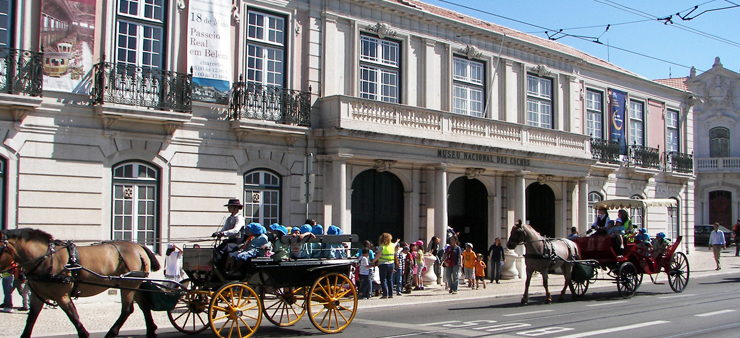Mission
It is the mission of the National Coach Museum to provide for the promotion, research and conservation of its collections in the firm belief that museums play a central role in the generation of human, social and economic growth. The recently inaugurated building leads the way in the making of new history for the museum, marked by our endeavour to include all of the necessary elements to accomplish this mission.
National Coach Museum
The new Coach Museum emerges, not only, as a cultural site but also as a public utility space. In the words of the architect Paulo Mendes da Rocha “the Museum has no doors and relates to all of its surroundings”. The project is more than a museum; in the end it functions as an urban infrastructure providing a public utility space for the city.
Thus, two concerns coexist; on the one hand the primary need to expand the exhibition area of the museum and its technical support infrastructure, while on the other, the need to create additional attractions for the most visited museum in the country. Moreover, there was a need to bind one of Lisbon’s most prominent fronts, the Belém monument area, where the construction of the new building has created a new dynamism in the museum’s surrounding area, creating new public spaces and urban walkways in the city that are reminiscent of earlier times.
The new Coach Museum building comprises a main hall with a suspended nave and an annex, which is connected by an overpass, enabling circulation from one building to the other. This layout creates a gantry like structure directed towards an internal square, where the old Rua da Junqueira buildings also face.
The new museum encompasses premises for the permanent and temporary exhibitions, reception halls, and a workshop for conservation and restoration, a contribution towards the development of conservation and restoration activities of this unique legacy.
New spaces have been provided for the Library and the Archive, as well as an Auditorium, which will allow for the organization of a number of cultural activities that will greatly improve the scope of the public programs offered by the museum.
To accommodate visitors, restaurant services, a Museum Shop and a Tourist Information centre have been projected.
Reference must also be made to the surrounding areas of the new building, specifically, the Museum Square, a free public access area intended for the development cultural and leisure activities.

Royal Riding School
On May 23, 1905 the “Royal Coach Museum” was inaugurated in Lisbon by initiative of Queen Amélia of Orleans and Bragança, Princess of France, daughter of the Count of Paris, who married King Carlos I of Portugal in 1886.The location chosen to accommodate the world’s first coach museum was in the antique hall of the Royal Riding School modified, specifically to this end, by the Court’s architect, Rosendo Carvalheira in collaboration with the painters José Malhoa and Conceição e Silva who, together, were able to achieve an almost perfect harmony between the location and the exhibition of State Vehicles.
Despite the great success, the lack of space was evident, and so in 1906, the Queen herself ordered a new project to extend the museum, so that the remaining vehicles of the Royal House, still stored in the many mews of the different palaces, could be exhibited.
Following the establishment of the Republic, on October 5, 1910, the museum’s collection grows, not only due to the arrival of a set of coaches and berlins from the extinct Royal House, but also due to the arrival of vehicles from the Church’s estate.
In 1911 the museum changes its name to National Coach Museum.
In 1944, a new hall designed by the architect Raul Lino is inaugurated, allowing for the exhibition of more vehicles, although, not yet the full collection, as the lack of space continued to be a problem.
In memory of the extraordinary work, initiated by Queen Amélia, which has protected the legacy of the horse-drawn vehicles, the Old Riding School will continue to accommodate an exhibition nucleus with coaches, berlins, the portrait gallery of the Royal Family of the Bragança dynasty, as well as, a number of cavalry accessories related to the Equestrian Arts.

Conservation and Restoration Workshop
The ample technical space provided by the new National Coach Museum, located on the ground floor encompasses the Conservation and Restoration Workshop site.
Given the wide range of materials and production techniques used, the conservation of animal drawn vehicles requires a multidisciplinary approach involving a cross between conservation and restoration expertise and the skills of traditional knowledge.
The Workshop has been devised to respond to the needs of the museum so as to guarantee the study and requalification of its legacy. It may also become a specialized conservation and restoration centre, operating as a training hub for national and international trainees and fellows.













